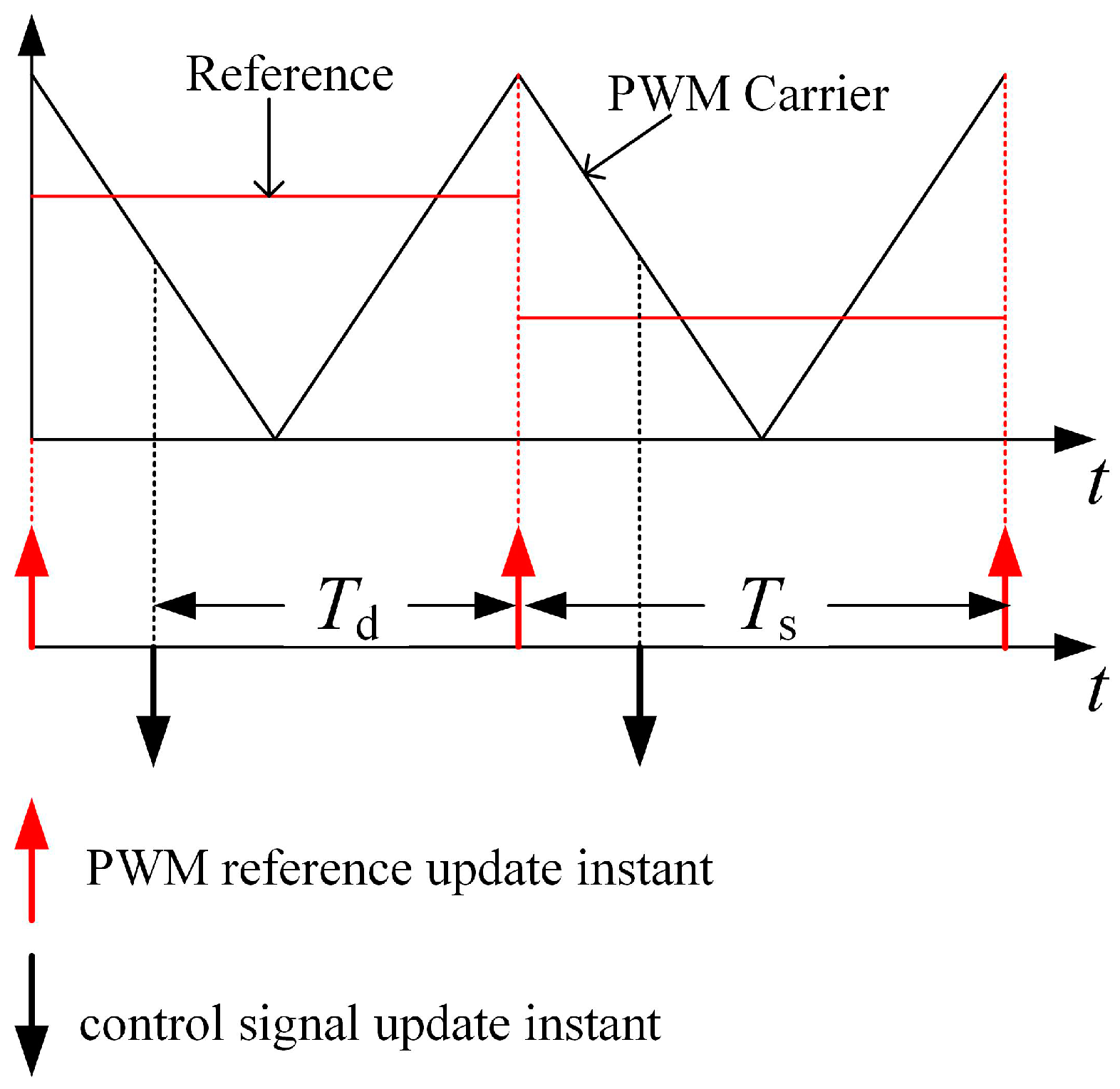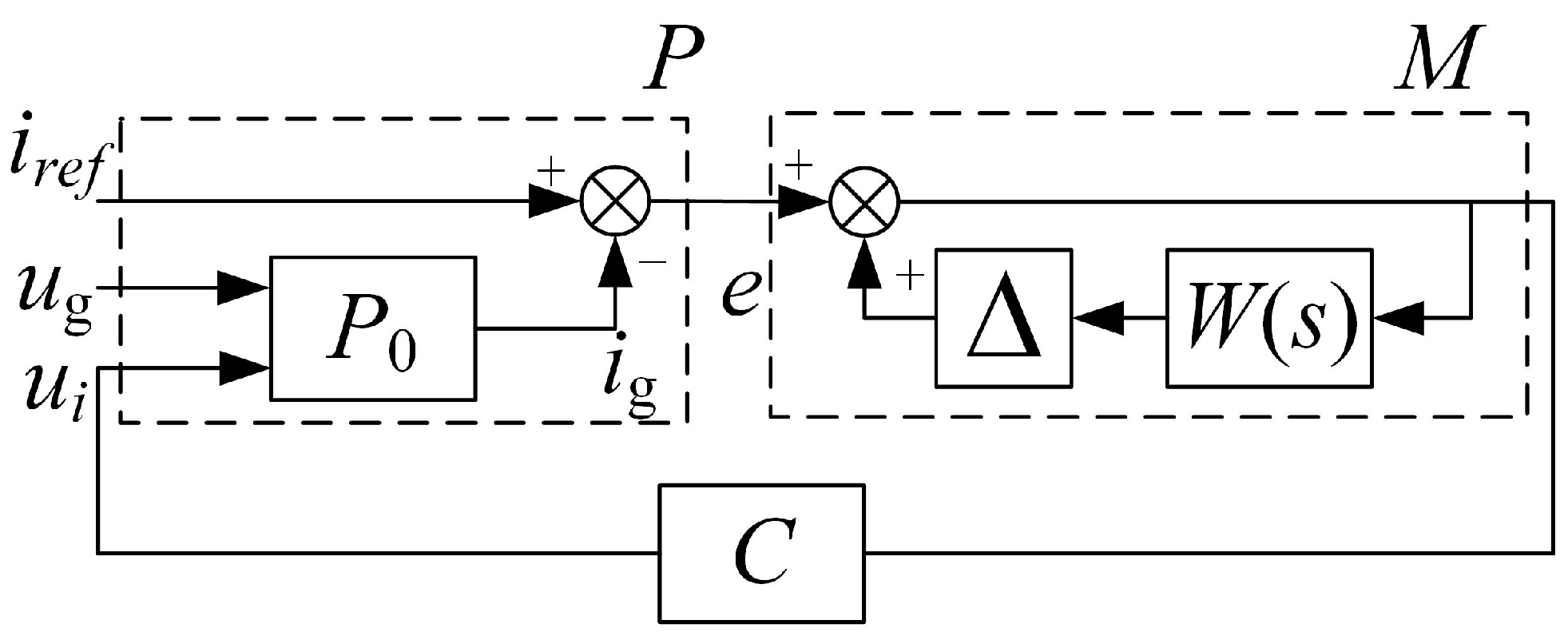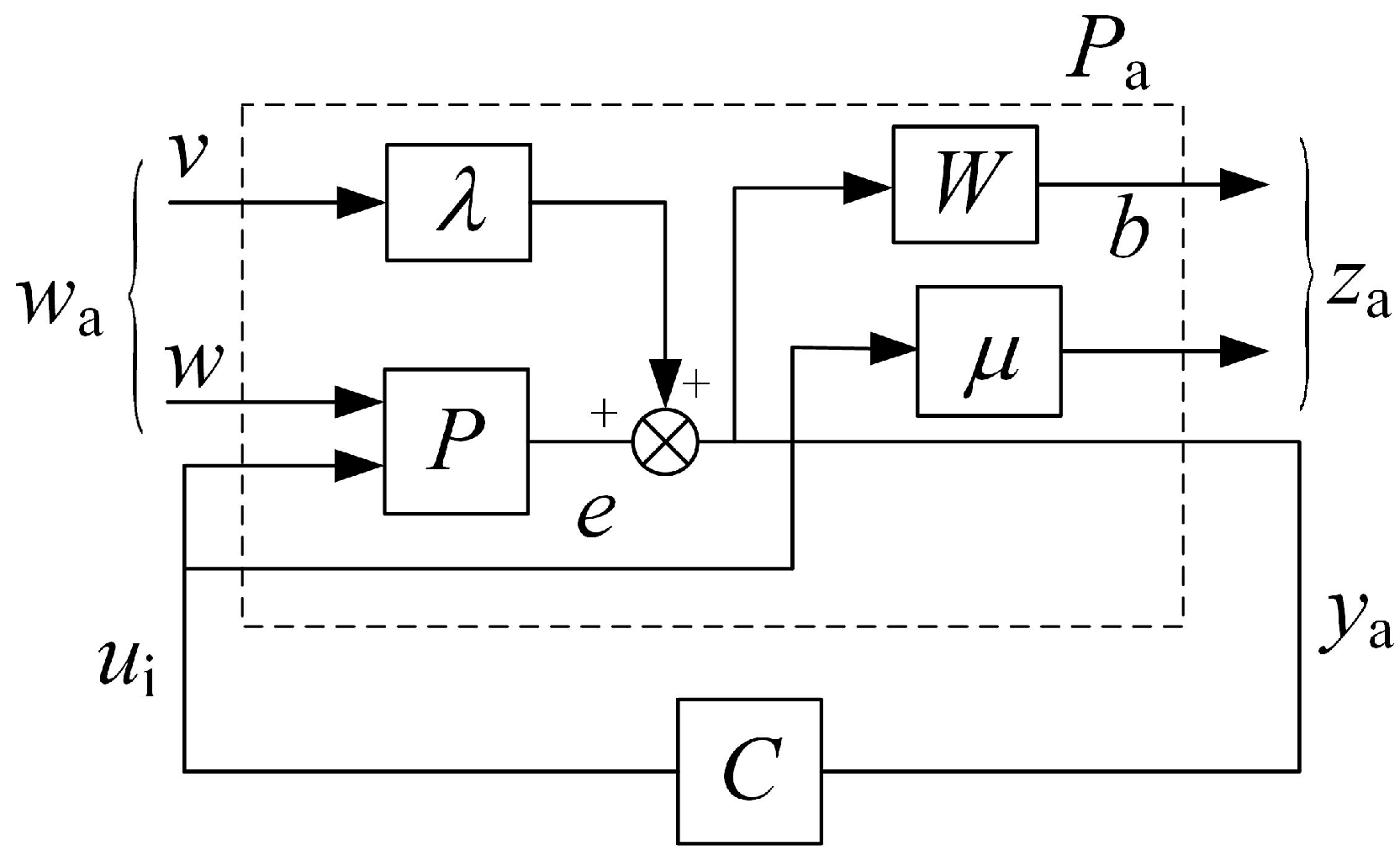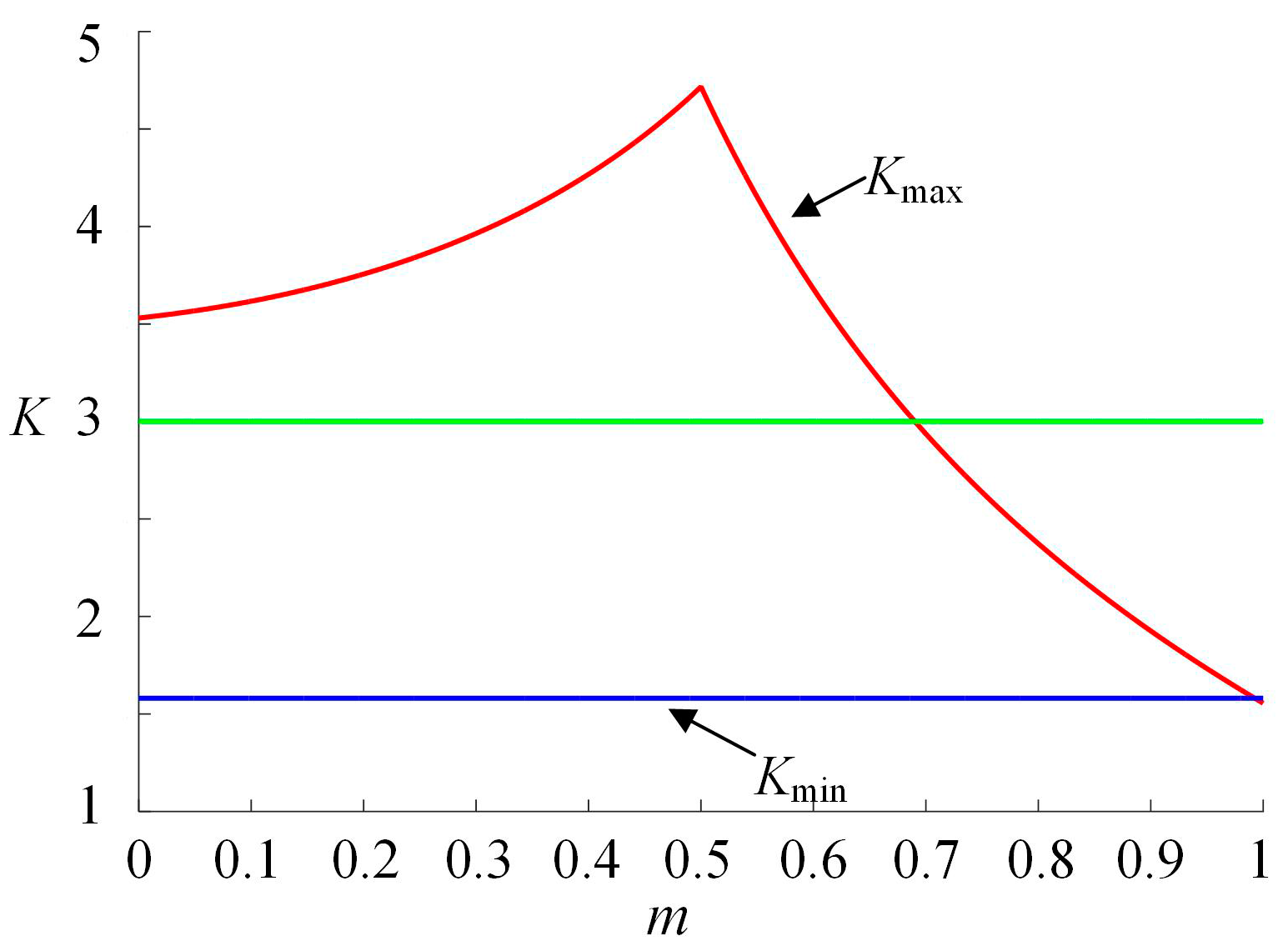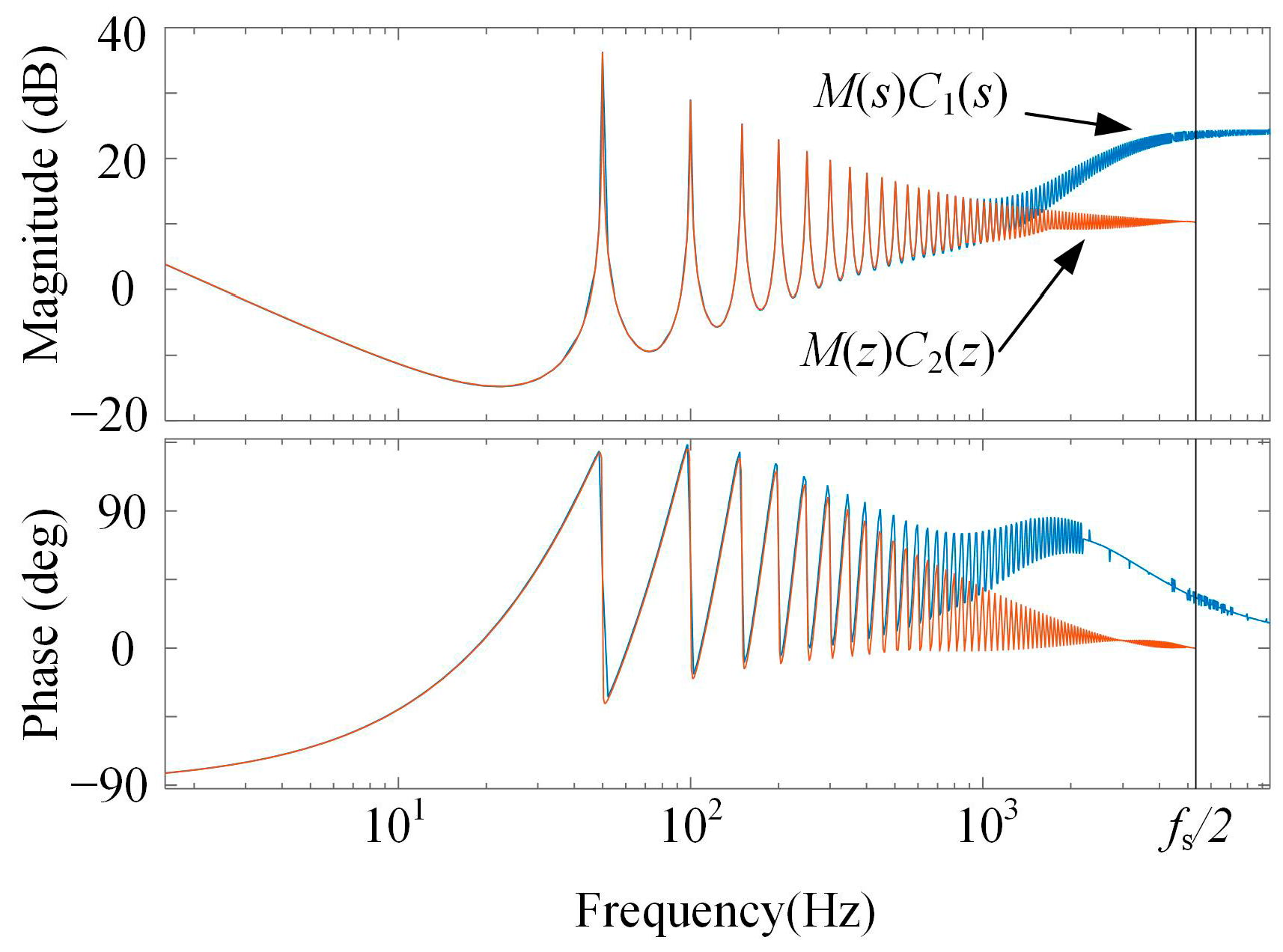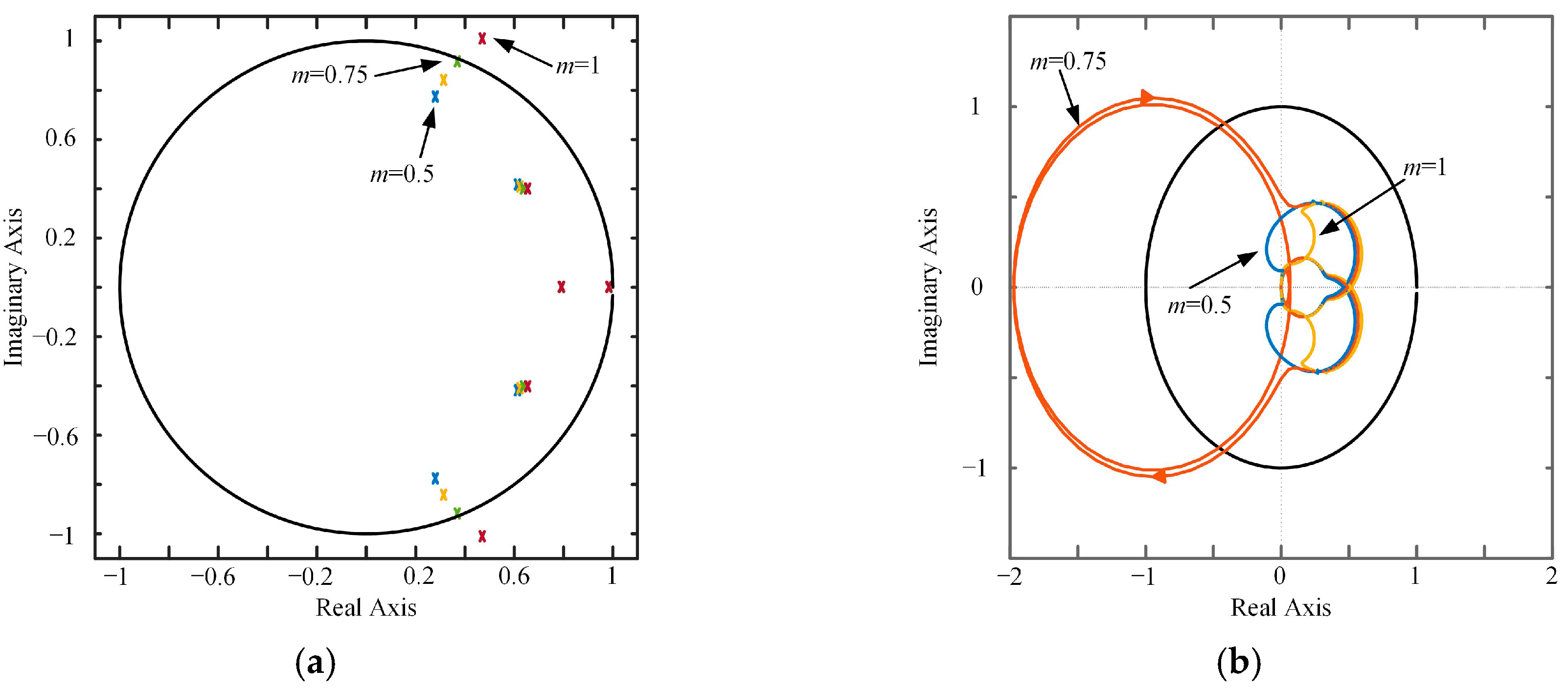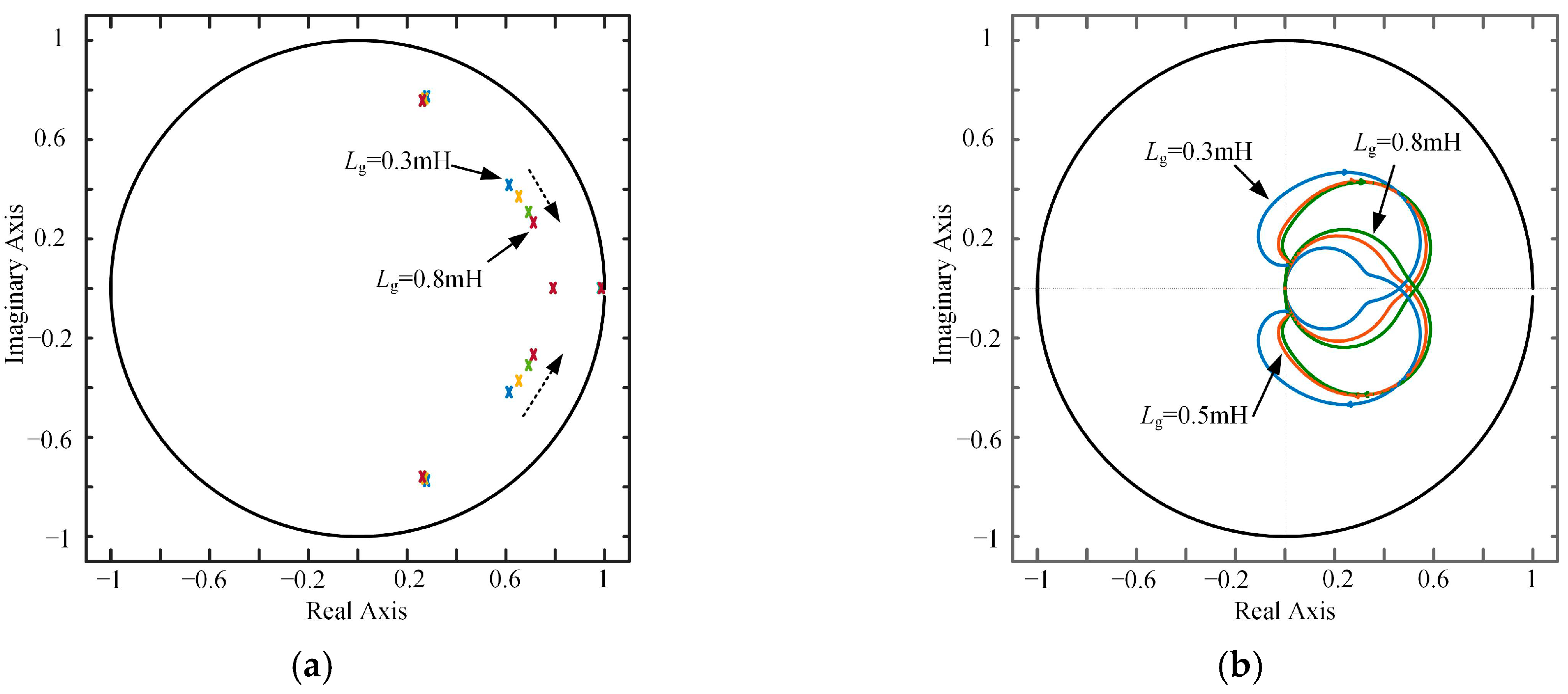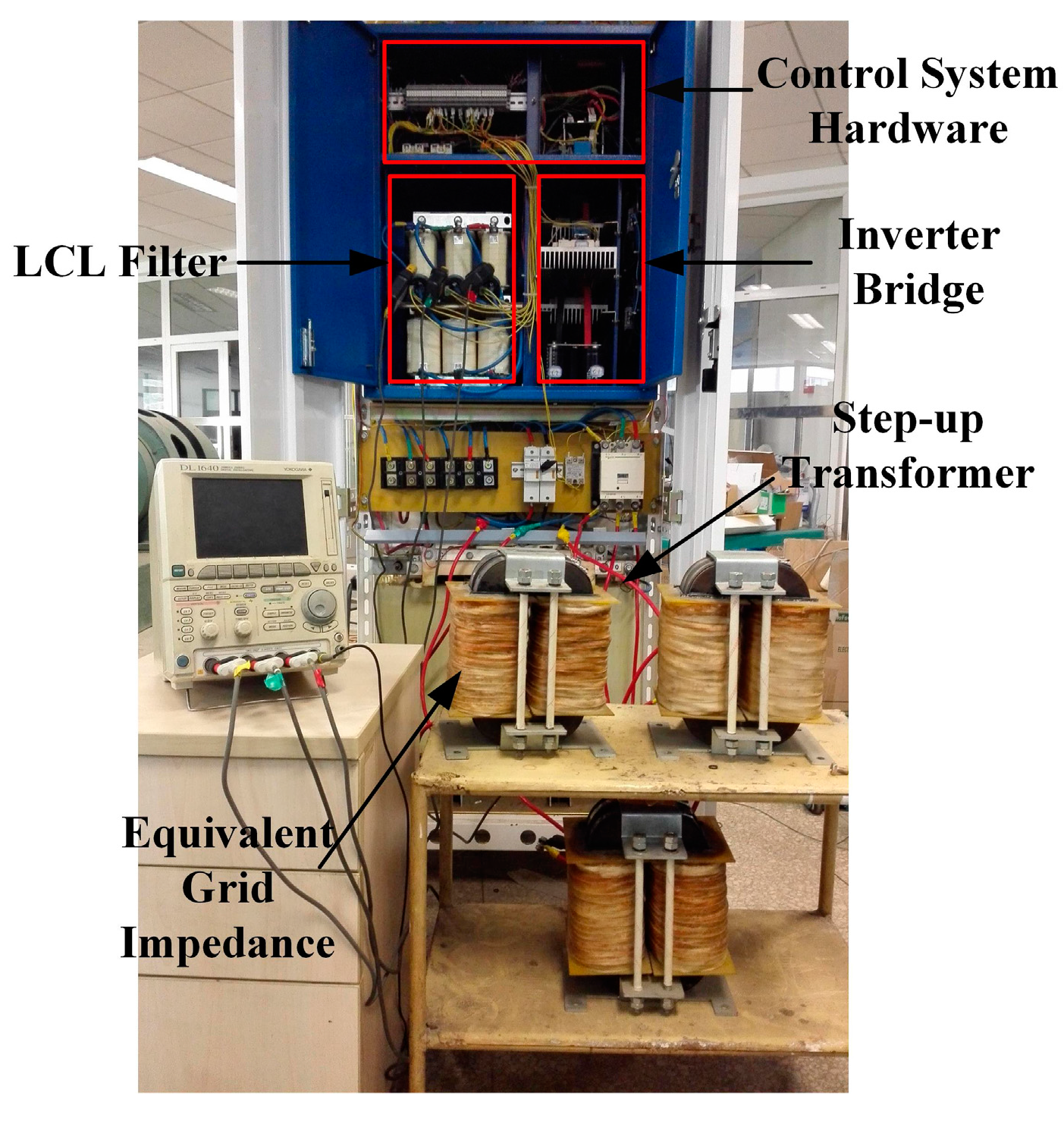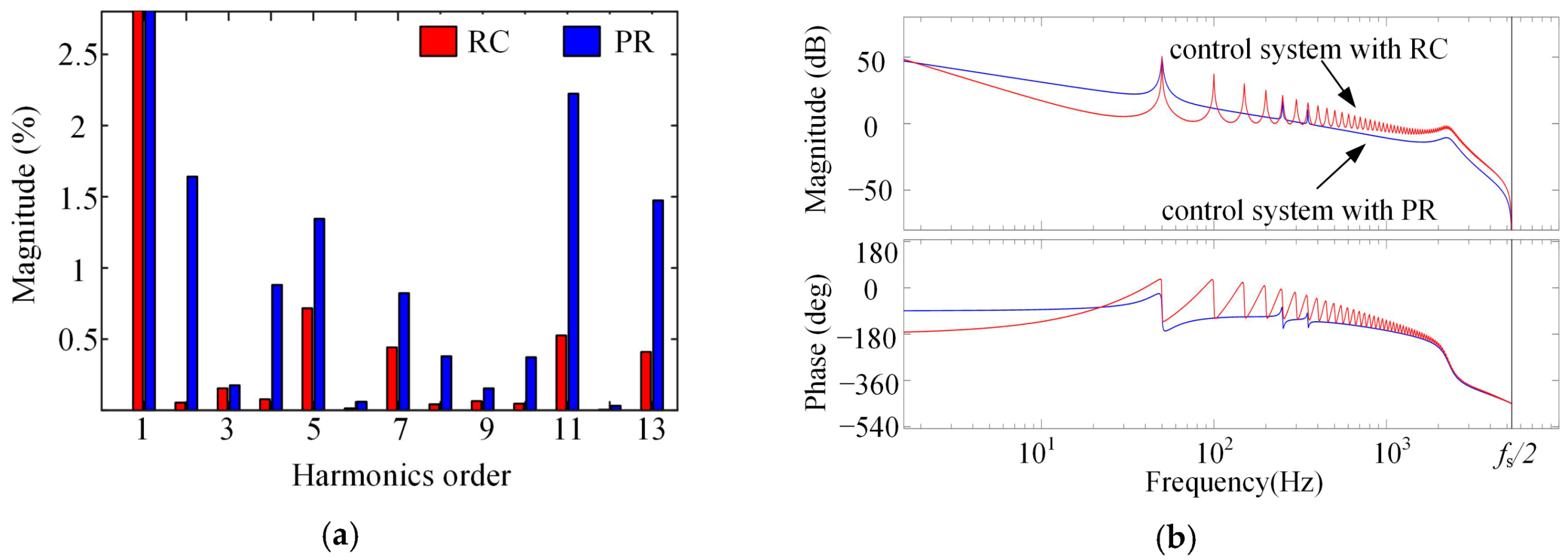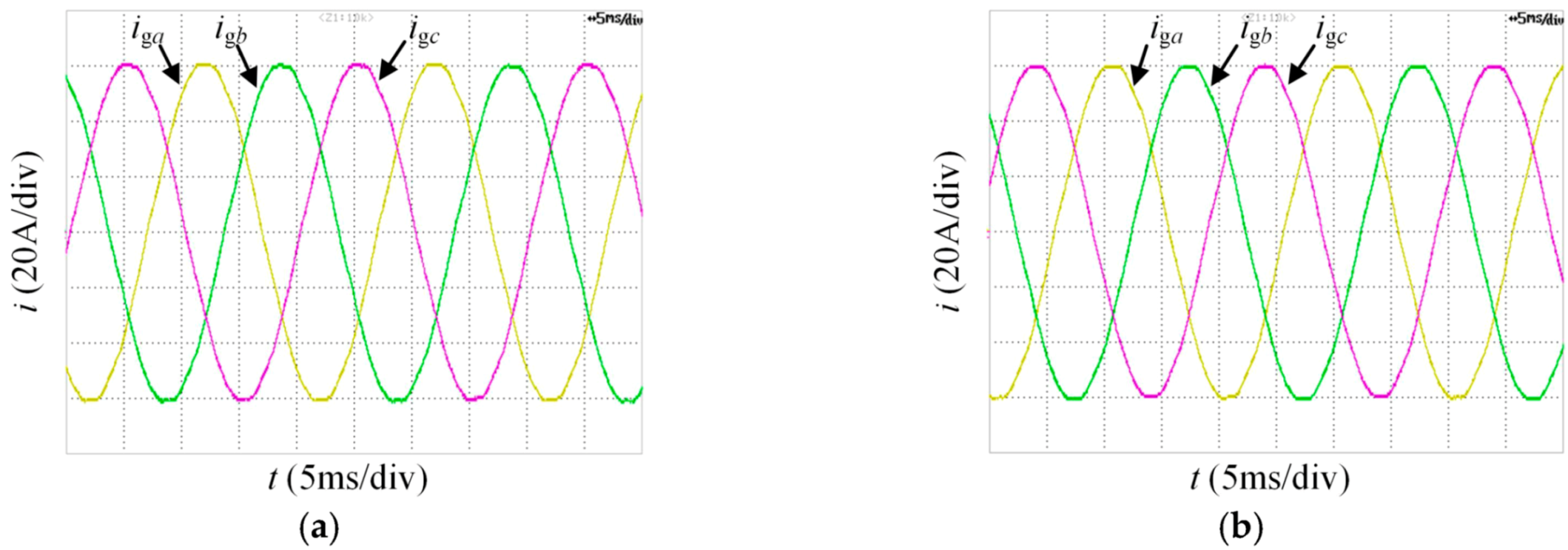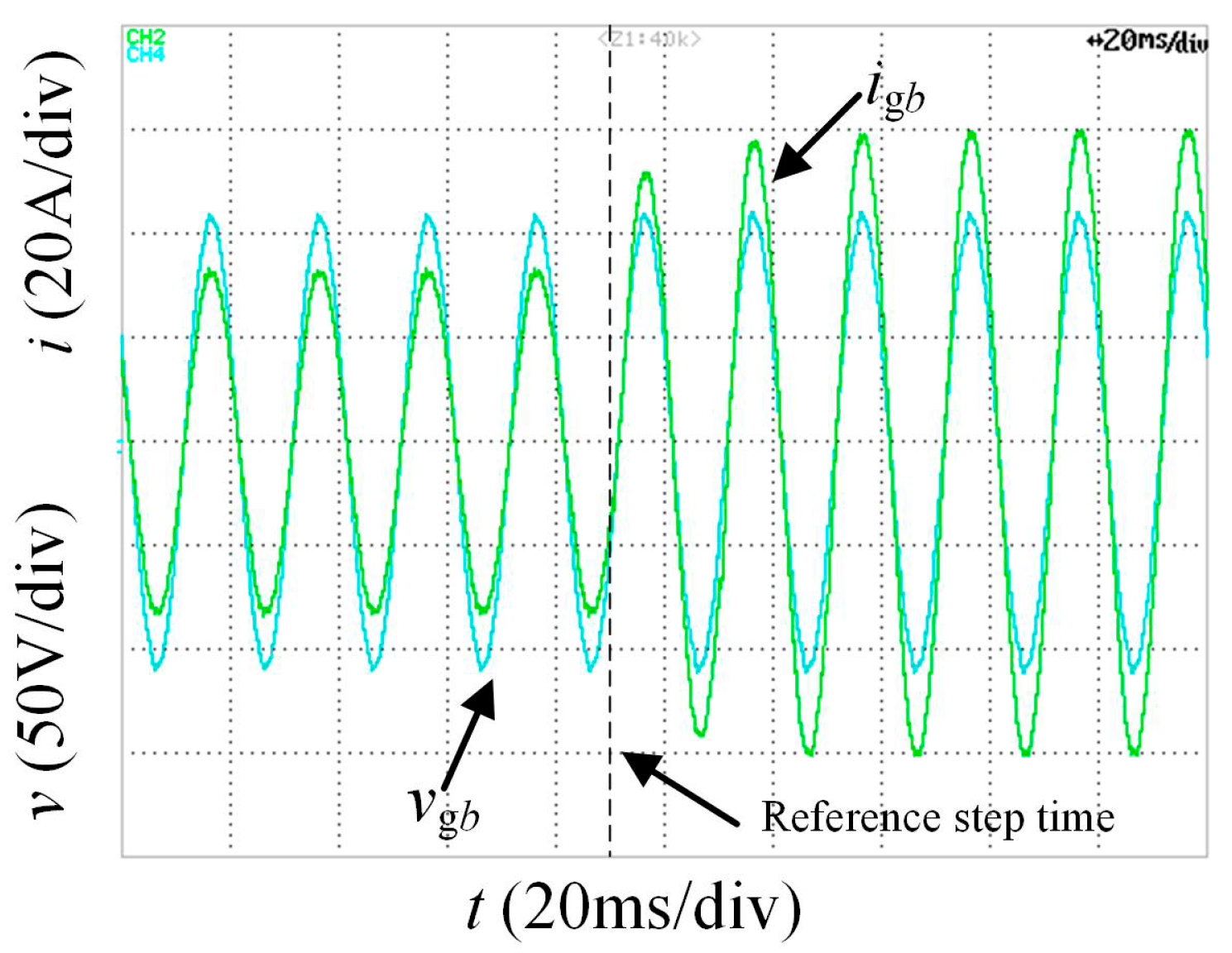1. Introduction
As the application of distributed generation is rapidly growing, the voltage-source-inverter (VSI) is commonly used as the interface between a distributed generator and the grid. While the VSI always works as the current source when it is connected to the grid, the harmonic distortion of the output current is a major issue as it can cause extra power loss and resonance of the grid. Therefore, the current control scheme of VSI should not only control the power output, but restrain the current harmonics injection.
LCL filters have been widely adopted in VSIs to attenuate the switching frequency harmonics [
1]. However, the resonance introduced by the LCL filter requires extra damping to guarantee the stability of the current control system. One common solution is passive damping, which adds extra resistance into the filter [
2]. This method increases the power loss of the LCL filter. Therefore, the active damping method has been proposed in references [
3,
4]. Without introducing additional resistance, the active damping strategy feeds back the state variable signal of the LCL filter into the control system to damp the filter resonance. Active damping avoids the power loss caused by additional resistance and provides more flexibility in adjusting the performance of the inverters. Several active damping methods have been proposed in recent years. Different state variables such as capacitor current [
5], capacitor voltage [
6], or inductor current [
4,
7,
8] have been used to damp the filter resonance. These methods have their advantages and disadvantages in practice. The advantage of the capacitor-current-feedback active damping is that the damping effect can be achieved via a simple proportional control of the feedback signal. Compared with other methods which introduce software filters [
4,
7,
8] or other control algorithms [
6] to realize the active damping, the adoption of proportional capacitor-current-feedback can reduce the complexity of the control system design and analysis. However, when capacitor-current-feedback is adopted to realize active damping in a digital control system, the computation delay and pulse-width-modulation (PWM) can affect the stability of the system [
9,
10]. As suggested in reference [
9], if the computation delay is one sampling period, a critical resonant frequency exists and is equal to 1/6 sampling frequency (denoted as
fs). Only when the resonant frequency of the LCL filter is less than the critical resonant frequency, can the feedback of the capacitor-current damp the resonance. The research in reference [
10] shows that an increase of the proportional coefficient can increase the equivalent resonant frequency of the damped filter, which may exceed the critical resonant frequency and destabilize the system. Therefore, two basic ideas have been proposed to extend the valid region of capacitor-current-feedback active damping. One is reducing the computation delay. This method was presented in reference [
10] based on virtual impedance theory when a proportional-resonant (PR) controller was adopted. However, only the reduction of the computation delay in the capacitor-current feedback loop was discussed. The relationship between the computation delay in the output-current feedback loop and system stability requires further research, especially when a more complicated controller is adopted. The other method is introducing an extra time-delay compensation unit. In reference [
11], a high-pass filter was introduced into the feedback line of the capacitor-current to compensate for the delay effects. Reference [
12] proposed a simple phase lead compensator into the feedback loop of the capacitor current. However, reference [
13] suggested that the noise amplification caused by the proposed compensator could be unacceptable, and a low-pass filer was needed in practice. Furthermore, a second-order-generalized-integrator was adopted in the control system for delay compensation [
13]. While the reduction of the computation delay can be limited by the hardware condition, the introduction of the compensation unit increases the complexity of the control algorithm. Thus, the proper method to expand the damping region should be selected based on the actual situation in practice. Moreover, the research presented in references [
9,
10,
11,
12,
13] has been based on the frequency domain analysis of the open-loop transfer function of the control system, and the system stability analysis is reliable only when a linear controller is adopted.
Aside from the switching frequency harmonics, the output current of a grid-connected inverter also contains low-frequency harmonics [
14] due to the grid voltage distortion and dead-band of PWM. However, the harmonics cannot be attenuated by an LCL filter. Therefore, the current control scheme of a grid-connected inverter requires the ability to reject the harmonics of the output current. For a three-phase grid-connected inverter, the classic proportional-integral (PI) controller implemented in the
d-
q reference frame cannot provide enough loop gain at harmonic frequency, which leads to poor harmonics rejection performance. Thus, other control strategies have been proposed to improve power quality [
15,
16]. PR controllers have been widely adopted in both single-phase and three-phase inverters [
17,
18]; however, to achieve better rejection performance, several PR controllers need to be connected in parallel [
19], which complicates the design and implementation of the current control scheme. To enhance the harmonics rejection performance and simplify implementation, repetitive control attracts more attention in current control application. Based on the internal model theory, the repetitive controller (RC) can track the periodic signal with small error and reject harmonic distortion [
20]. In references [
20,
21], the control scheme was adopted to control the output voltages and currents of uninterruptible power supplies and grid-connected inverters. The study in reference [
22] proposed a RC, which was based on H∞ repetitive theory. Due to the simple structure and excellent tracking performance, the scheme was adopted in current control for grid-connected inverters in references [
23,
24]. However, the RC designed in references [
23,
24] was based on passive damping, and the extra power loss caused by the additional resistance cannot be neglected, especially in practical applications.
Based on the above-mentioned analysis, the current control system of the grid-connected inverter with an H∞ RC can achieve better performance and efficiency by introducing active damping. However, due to the existence of three major problems, the H∞ repetitive control scheme cannot be directly applied to the current control when active damping is adopted. First, the signal which is fed back to realize active damping introduces an extra measurement signal aside from the output current of the inverter, which needs an additional controller based on H∞ repetitive theory. The additional controller makes the simplification of the control scheme very difficult considering the interaction between the two feedback signals. Second, the design procedure presented in references [
23,
24] for the RC did not consider the computation delay of the digital control, which can destabilize the current control system especially when active damping is adopted. Third, the existing stability analysis for the system with the H∞ RC was carried out based on a continuous time model. The results were inconclusive once the discretization of the proposed controller and delay effects were considered. Furthermore, the stability analysis method presented in references [
9,
10,
11,
12,
13] was not suitable in this situation as the RC is non-linear.
Thus, a modified method is proposed in this paper to design H∞ RC for LCL-type grid-connected inverters which can overcome the existing problems mentioned above. Compared with the traditional design method, the new design method introduces the active damping into the controller design process based on H∞ theory. Furthermore, a stability region for the control parameters’ choice is presented to avoid the system destabilization caused by the digital control delay. Finally, by considering that the proposed RC is a typical non-linear control strategy, a stability criterion for the discrete current control system with H∞ RC is proposed based on small gain theorem.
Specifically, a novel controlled plant model based on the LCL filter with active damping was built in the paper. Thus, the design of the RC could be based on a single-input-single-output (SISO) plant without considering the impact of the active damping feedback signal. Furthermore, the proportional capacitor-current-feedback active damping was adopted to avoid the extra controllers of other active damping methods which could introduce additional poles and increasing the order of the controlled plant. To avoid the introduction of delay compensation units, the reduced computation delay of both the capacitor-current feedback loop and output-current feedback loop was introduced to extend the valid region of active damping. The discrete model of the controlled plant with variable computation delay was derived in the paper to study the stability of the system. Based on the discrete model, the stable region for the proportional coefficient of the capacitor-current-feedback was proposed under variable computation delay. Thus, the reasonable proportional coefficient and computation delay could be selected according to the stable region. Moreover, based on the proposed stability criterion for the discrete control system, a comprehensive analysis of the system stability was conducted by studying the delay effects and the simplification of the proposed controller.
A design example was also provided in this paper along with the stability and robustness analysis. The proposed H∞ repetitive control scheme was tested in a 10 kW LCL-type three-phase grid-connected inverter. The validity of the proposed design method and the performance of the RC were verified through experiments and simulation results.
The circuit topology of the grid-connected inverter and the structure of the current control system are presented in
Section 2.
Section 3 discusses the design procedure of the H∞ repetitive controller, and proposes the stable region of the active damping coefficient and the stability criterion. The design example is presented in
Section 4, along with the stability analysis which takes into account the variation of the computation delay and grid-impedance. The simulation and experimental results are shown in
Section 5. Finally, conclusions are drawn in
Section 6.
2. Model and Analysis of the Current Control System
The circuit topology of a three-phase LCL-type grid-connected inverter is shown in
Figure 1. As the topology illustrates, the inverter is connected to the local distribution grid through a step-up transformer, denoted as T. The LCL filter is composed of the inverter-side inductor
Ls, the grid-side inductor
Lg, and the capacitor
C. The current control system in
αβ-domain is also shown in
Figure 1. Through
abc-
αβ transformation, the three-phase grid-side output current
ig_abc is introduced into the control system as a feedback signal. The active damping is implemented by introducing the proportional feedback of the three-phase capacitor-current
ic_abc. The three-phase voltage of the point of common coupling (PCC) is denoted as
ug_abc. PLL is the phase-locked loop. Two identical current controllers represented by
GRC are adopted to control the injected power and to reduce the total harmonic distortion (THD) of the output current.
Since a balanced three-phase inverter can be converted into two identical decoupled single-phase inverters through
abc-
αβ transformation, and the design and analysis for the current control scheme in this paper were based on a single-phase inverter model. Based on
Figure 1, the diagram of the single-phase current control system is shown in
Figure 2. The output current, capacitor current, and phase voltage of PCC are represented by
ig,
ic, and
ug.
iref represents the current reference, which synchronizes with
ug.
Kpwm is the PWM gain of the inverter and
Kpwm =
Udc/2 for the half-bridge circuit topology is shown in
Figure 1.
Kc is the feedback coefficient of
ic.
According to reference [
22], the controlled plant should be a single-input-single-output system to simplify the current controller design; however, the active damping makes the controlled plant have two feedback signals, which are
ig and
ic. Thus, an equivalent transformation of the control system is presented in
Figure 2. By moving the feedback note of
ic after the
Kpwm unit, the new feedback coefficient
K is obtained and
K =
KcKpwm. Therefore, the feedback of
ic is considered as part of the filter. In addition, the input of the equivalent controlled plant is
ui.
When the control scheme is implemented in a digital control system, the delay effects and PWM have serious impacts on system stability. Therefore, the computation delay e
−Tds and the zero-order hold (ZOH) unit are introduced into the control model (
Figure 2). The detailed delay mechanism of the proposed system is illustrated in
Figure 3.
Ts represents the sampling period of the digital control, which is equal to the PWM period. Theoretically, the computation delay time
Td can vary from 0 to
Ts by changing the control signal update instant. However,
Td should be long enough to complete the computation of the control algorithm in practice.
5. Simulation and Experimental Results
According to the circuit topology (
Figure 1) and the power circuit parameters (
Table 1), a 10 kW three-phase grid-connected inverter was built in the laboratory to test the performance of the control scheme. A DSP (TMS320F28335) processor (Texas Instruments, Dallas, TX, USA) was selected to implement the current control scheme. Two high-accuracy analog-to-digital converters (MAX1320, Maxim Integrated, San Jose, CA, USA) were adopted to sample the voltage and current signals. The power switches used in the inverter were insulated-gate bipolar transistor modules FF450R12KT4 (Infineon, Munich, Germany). The maximum rated collector-emitter voltage and continuous collector current of the insulated-gate bipolar transistor (IGBT) were 1200 V and 450 A. As shown in
Figure 1, the sinusoidal pulse width modulation (SPWM) was adopted in practice. The inverter was connected to the local distribution network through a 130 V/400 V transformer. The experimental setup is illustrated in
Figure 11.
Based on
Section 4, the major parameters of the current control scheme are shown in
Table 2.
Furthermore, based on Equations (19) and (22), the discrete transfer function of the current controller G
RC can be expressed as:
Additionally, the model of the grid-connected inverter along with the control scheme was built in MATLAB/Simulink (MathWorks, Natick, MA, USA) to verify the stability of the control system. As mentioned in
Section 1, the dead-time of the power switches is one of the major causes of the output current harmonic distortion. Thus, the dead-time was considered in the simulation and experimental studies.
The introductions and conclusions for different test scenarios are summarized as follows:
The stability verification of the proposed current control scheme is illustrated in
Section 5.1. The results prove that the system with the proposed RC was stable when
K = 3,
Td = 0.5
Ts, and the system could be destabilized when
Td was increased to 0.75
Ts or
Ts.
The steady-state responses of the current control scheme with proposed RC are illustrated in
Section 5.2.1. A multi-frequency PR controller was designed and adopted in the same current control system as a comparative trial. The experiment results prove that the proposed RC could provide better harmonics rejection performance with lower control algorithm complexity.
The steady-state responses with different grid-impedances are illustrated in
Section 5.2.2. The results verify the robustness of the proposed RC against the variation of grid-impedance.
The transient response of the proposed control scheme under the step change of the current reference is illustrated in
Section 5.2.3.
5.1. Stability Verification Based on Simulation
An unstable current control system can lead to serious overcurrent and distortion of output power when the inverter is connected to the grid; therefore damage to the experimental device can be inevitable in this situation. Thus, the stability verification was carried out in a simulated environment, with the results shown in
Figure 12.
Figure 12a illustrates the full-load steady-state output current of the inverter when
Td = 0.5
Ts where a balanced three-phase current output with low harmonic content was achieved in this situation. In
Figure 12b,
Td was changed to 0.75
Ts at 0.02 s, and it can be seen that a serious current distortion has occurred. In
Figure 12c,
Td was changed to
Ts at 0.02 s, and the distorted output current increased rapidly after the change of computation delay.
Based on the simulation results, the analysis in
Section 4.3 was verified and the current control system was unstable when
Td = 0.75
Ts or
Td =
Ts.
5.2. Experimental Results
5.2.1. Steady-State Responses
The proposed H∞ RC was implemented on the experimental platform and
Td was set to 0.5
Ts, based on the theoretical analysis and simulation results. Furthermore, a PR control scheme was designed based on references [
5,
10] with the same
K and
Td. As it is known that one single PR controller can provide high gain at a certain frequency, multiple PR controllers are always connected in parallel to track the given reference and compensate the harmonics. However, as each PR controller is 2-order, the implementation of the multi-PR control scheme causes much longer computation delay when compared with the proposed RC.
Considering the limited computation delay allowed in this scenario, three PR controllers were connected in parallel to track the fundamental current reference and reject the 5th and 7th harmonic currents. The PR scheme was implemented on the same platform as the comparative trial to verify the performance of the proposed RC current control scheme.
Figure 13 shows the steady full-load output current of the grid-connected inverter with different controllers, and the waveforms of three-phase output current and the voltage of phase B at PCC are illustrated. The spectra of the output current of Phase A with different controllers are presented in
Figure 14a.
As the spectra shows, the proposed RC can reject not only the 5th and 7th current harmonics as per the PR controller, but also the harmonics at other frequencies, such as the 2nd, 11th, and 13th. While the THD of the output current with the PR controller is 3.7483%, the THD decreased to 1.2321% when the proposed RC was adopted. The Bode plots of the current control systems with different controllers corroborated the harmonic analysis results. As shown in
Figure 14b, the proposed RC could introduce higher open-loop gain at each harmonic frequency (including at the 5th and 7th harmonic frequencies). As a result, the output current had lower harmonic content. Although the introduction of
W decreased the gains of the harmonic frequencies larger than the bandwidth of the low-pass filter, the H∞ RC was still very effective when the low-frequency output current harmonics are the major concern in practice.
5.2.2. Steady-State Responses with Different Grid-Impedance
To verify the robustness of the proposed RC against the variation of grid-impedance, an inductor was connected in series with
Lg as the equivalent grid-impedance. As
Section 4.4 describes, the experiment was carried out when
Lg = 0.5 mH and 0.8 mH. As
Figure 15 illustrates, the waveforms of output currents have rare differences when compared with
Figure 13a, thus, the proposed control system was proven to be stable with the variation of the grid-impedance.
5.2.3. Transient Response
The transient response of the proposed controller was tested by stepping the output current reference from half-load to full load. The waveforms of the output current and voltage of Phase B at the time when the reference step occurred are shown in
Figure 16.


